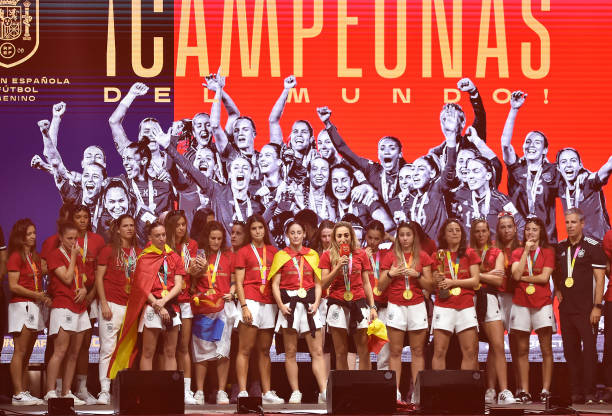
Nowadays, there are two countries that are being protagonists in the world of football; one is Saudi Arabia, for the impressive investment they are making in their league, hiring some European football figures. The other is the United States, due to the shock and commotion caused by the arrival of Lionel Messi at Inter Miami and it does not seem that it is going to stop here since the North Americans, along with Mexico and Canada, will be the hosts of the next FIFA World Cup, so It is to be expected that they will continue trying to arouse greater interest from around the world.
🗓️👀 Sunday 19 July 2026, we do it all again… 🏆#FIFAWorldCup pic.twitter.com/SLO22tP70C
— FIFA World Cup (@FIFAWorldCup) March 14, 2023
This will be the 23rd edition of the competition and the first to have three countries as hosts, in addition to including changes in the number of participants and in the format. In addition to the fact that the three countries combined have a huge geography that is expected to be used for the tournament, so the transfers and the dynamics of the competition are going to be different from what has been seen in other editions of the FIFA World Cup.
Hosts
After several changes of idea in what was going to be the criteria for the selection of the organizing country where it was about establishing which were the conferences that could include a candidate as well as the number of countries that could make a bid together. Finally, it was decided that UEFA (Europe) and AFC (Asia) could not make a bid because they had been the last two hosts of the FIFA World Cup and there was no limit on the number of countries that could apply as long as they complied with the minimum requirements established by FIFA for an organizing country that are focused on aspects such as training facilities, stadiums, hotels, transportation, etc.
In the end, there were only two bids: the African one, with Morocco and the CONCACAF one with Mexico, the United States and Canada together under the name of United 2026. The latter defeated the Moroccans in the vote by 134 to 65 votes. All three countries have vast experience in tournaments organized by FIFA and Mexico would become the first country to have hosted three World Cups. One of the main concerns regarding this joint organization of three countries and especially three countries with such a large geography is the distances that the teams will have to travel to play their matches, something that can add up in hours of travel and for consequently in fatigue and less training time.
Venues
In this sense, FIFA presented the 16 venues distributed in three regions, which seems to be part of a strategy for the distribution of the matches so that the trips are shorter, at least in the group stage matches.
The largest concentration of venues is in the United States, which contributes 11 cities, while Mexico contributes 3 and Canada only two, although these two Canadian venues (Vancouver and Toronto) border the United States and in the case of Mexico, Monterrey is located, which is in a region close to the country of stars and stripes and that is another strategy that can help reduces the impact of long distances.
The list of venues is completed by Guadalajara, Los Angeles, San Francisco, Seattle, Atlanta, Dallas, Houston, Kansas City, Mexico City, Boston, Miami, New York and Philadelphia.
Format
Since the first FIFA World Cup in 1930, the tournament has been increasing the number of participants and has been testing different formats, for example, in that edition, there were 13 teams from three confederations, with a group stage that had a group of four teams and two groups of three teams, where the top teams in each group met in the semifinals to later decide the champion in the final. This format has changed over time and FIFA has been including more and more teams until reaching the 32 that participated in Qatar 2022 and now the 48 that will be held in 2026.
Logically, with more participants, the number of matches increases, which in this case goes from 64 to 104, which brings a greater economic benefit considering the number of spectators that each edition of the tournament has. Changes are also introduced in the format where we went from eight groups of four to 12 groups of four, where the first two places and the best eight third places will classify. The 32 qualified teams enter the knock-out round until they reach the final.
The increase in participants also increases the number of slots for each confederation to qualify for the final phase of the tournament, based on the fact that the 3 national teams that are hosts are already automatically classified, which is why they will not participate in the qualifiers for CONCACAF. Thus, we have that Asia (AFC) goes from having 4.5 places to 8.33, Africa (CAF) goes from 5 to 9.3 places, being the most benefited with the increase in participants, North America (CONCACAF) goes from 3.5 to 6.66 places, South America (CONMEBOL) from 4.5 to 6.33, Europe (UEFA) from 13 to 16 and Oceania (OFC) from 0.5 to 1.33.
In previous qualifiers, the 0.5 referred to a playoff qualification while the 0.33 that is now being implemented refers to an international playoff spot. CONCACAF is given an additional 0.33 for that play-off as the host confederation.
Clearly, this next edition of the FIFA World Cup will not leave anyone indifferent and in fact, there are already many opinions about the real reasons for increasing the number of participants and the impact that this can have on the quality of the tournament. Simply, we will have to wait to see how everything develops and carry out a review of the good and bad that it leaves behind on July 19, 2026, when the final is played.
However, there is of course a massive desire for this edition of the World Cup to be a massive success and to be a phenomenal event.
2026 #FIFAWorldCup Emblem: Launched ✅🔥#WeAre26 pic.twitter.com/IiKaQKRkS6
— FIFA World Cup (@FIFAWorldCup) May 18, 2023

Must See
-


Champions League
/ 10 months agoChampions League – Matchday 2
Almost in the blink of an eye we reached the second day of the...
-


Premier League
/ 10 months agoThe bad start for Poch’s Chelsea
Since Todd Boehly’s arrival as club owner in the summer of 2022, Chelsea have...
-


Premier League
/ 10 months agoJadon Sancho’s feud with Erik Ten Hag continues
Manchester United winger Jadon Sancho’s time at Old Trafford has been torrid, to say...



